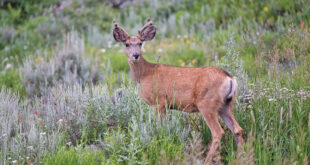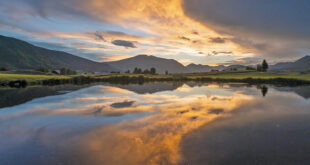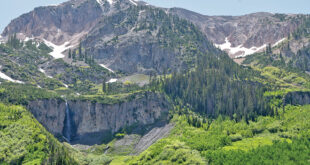About the time the winning duck crossed the finish line at Totem Pole Park on Sunday, we probably crested the summer craziness hump. Summer season is always a hump and this one felt humpier than most.
Maybe it was the heat that seemed more excessive than usual in the heart of the summer. Perhaps it was what apparently was a short four-day monsoon season. At least those rains came when a wildfire was flaring around the corner from both Crested Butte and Gunnison. Could it have been the busyness that used to start in July now beginning in June? The jackhammers? Allergies? The lack of places to eat and drink with friends?
Until the end of CB Arts Fest weekend, people are definitely testier and have less patience in the midst of the summer tourist season. Locals are more likely to yell at the car trying to figure out the Clark’s parking lot or shake a finger at strangers going the wrong way on one of the mountain’s biking trails.
Every summer is busy and tests our patience, but when the Arts Festival concludes, we can normally count on the crowds thinning, the morning temperatures dropping and neighbors who have been working hard to fill up the bank accounts for off-season can at last take a little breath.
It was in those testy days before Arts Festival weekend when I first looked over the draft of the Phase Three Crested Butte Transportation and Mobility Plan. Yeow. It seemed to me full of not just change – which is okay if done thoughtfully – but major change for change’s sake, change to prove the valley’s sustainability cred or change that is more appropriate if CB was a giant resort town and county seat along the interstate. The extremely dense plan putting forward 50+ actions certainly doesn’t start with the premise of “Do no harm.” It sure didn’t consider the price tag.
But Tuesday night during the town council work session, the council members did what they are charged with — they acted as a check on the draft ideas and listened to their constituents. They dismissed the idea of opening the Butte Avenue bridge to one-way vehicular traffic. That gives me confidence for how the rest of the plan might proceed and there is a lot in that plan that impacts everyone not just in town but the entire valley. Plus, I reread the plan after Arts Fest weekend and took a breath. There are still some raised eyebrows but Tuesday’s council action and staff reaction gave me end of summer season hope.
My first overall testy reaction to the draft was that while claiming to be a plan centered on de-emphasizing automobiles, it was pushing them to places in Crested Butte that are relatively absent of cars — the northwest part of town and one of my favorite places — the alleys of CB. As someone living outside of town, one general message seemed be, “don’t drive here unless maybe you’re working or spending your money in town.”
The plan doesn’t seem to adequately acknowledge that compared to almost anywhere else in America, this place has more people per capita walking or riding a bike to get around in the summer (and sometimes even winter). Crested Butte has a real bike and pedestrian culture. That should be celebrated and expanded with carrots before threatening action with sticks. Look at perhaps copying Mt. CB’s successful idea of e-bike rebates for people who commute to town for work. That would eliminate some vehicle traffic quickly and relatively inexpensively.
Let me throw out what to some will be a controversial or just plain stupid statement: There is not a continual gigantic traffic and mobility problem in Crested Butte. It’s been expected to happen for decades but has not materialized. There is a seasonal spike in negative traffic issues that can at times be a cluster. There are certainly major and serious traffic issues such as the Red Lady Avenue and Sixth Street intersection during the school year, and Lord knows there is an increase in congestion, speeding and overall bad auto behavior for six or seven weeks of the year. July traffic can just plain suck, as can a few weeks in ski season. It can take longer to get through the Four-Way and people drive too fast on Whiterock in the summer. Does the town need a complete overhaul of all thing’s transportation that, for example, would require residential parking permits in every square inch of Crested Butte 52 weeks a year? I’m not buying it.
I purposely keep an eye on downtown Elk Avenue in the summer. I drive it, ride my townie and mountain bike on it, and walk it. Rarely is there not available parking on any given block. Yeah, it’s busy. Some SUVs let out passengers at Third and Elk, and people are crossing where they shouldn’t, but I don’t see complete mayhem. I see busyness that is sometimes over the top, but if you’ve visited other resort communities in the summer you might know that it’s pretty tame here.
Looking down from the Eldo deck the Monday evening after Arts Fest (the second busiest weekend of the summer), there were literally three cars traveling the street at dinner time and plenty of parking. Staff readily points out there is not a parking space problem in town, there is a parking space management problem in town. So why impose things like a mandate for residential parking permits on every street? Why make the alleys like streets? Why add probably tens of millions of dollars in costs to the town and local transit systems without talking about how to pay for it? Basically, if we are planning a major overhaul of several elements of this small town, the measures being pursued should be clearly defined and the mitigations the least intrusive for everyone. While touted as just a template to be used far in the future, I sense there are some ready to implement as much of this plan as they can as soon as they can.
For me, moving cars off the streets and into alleys would be particularly annoying. The plan suggests “deploying the alleys to reduce traffic on residential streets.” Alleys are the essence of a Crested Butte “rough edge” everyone says they want to maintain, and they are perfect pedestrian thoroughfares. Alleys are another place locals walk the dogs and decompress from the busyness of the main streets. They are a midtown place of peace. Why screw all that up to take a few cars off Maroon or Sopris?
One of the plan’s architects, Troy Russ said he walks to work at the Crested Butte town hall every day from his home in Mt. CB no matter the weather. “I hate cars,” he stated unequivocally. I respect that and admire his literally walking the talk. I don’t hate cars and while I sometimes bike to work, I admittedly drive more.
Keeping the Butte Ave. bridge car-free was a good council decision. So many people like and use the pedestrian/bike-oriented area on Butte Avenue. Most probably don’t reside in that neighborhood. It is not a gated community and can be enjoyed by anyone. It is a perfect area to walk the aging dog. It is a model for other neighborhoods. I doubt having that bridge open to one-way traffic would turn it into I-70 since most locals understand the Sixth Street bypass alternatives work better off Teo and Gothic.
Remember do no harm? Even after re-reading it in a better frame of mind, pain seems to be a theme in the draft. Make it painful to park anywhere in town. Distribute more parking tickets all over town. Get rid of heated sidewalks on Elk Avenue so people can feel the actual pain of falling in the winter which is a common occurrence and pretty painful. On top of the two-hour parking max with residential permits, perhaps limit parking at the Four-Way to four hours so outliers from the suburbs can’t use it as a park-n-ride to catch the bus to the ski area. Painful. Sticks over carrots.
There are many suggestions in the plan to have the two organizations that might work better than any other local quasi-governmental organizations, the Mountain Express and the RTA, veer from their current missions and charge them with huge, new responsibilities. I didn’t see any mention of cost analysis for those ideas but that too would involve pain. Between the Mountain Express and RTA, the annual operating budgets are about $7 million. The ideas in the plan would easily push that annual cost well into the double-digit millions of dollars — I smell another request for a tax increase in the future. Just that idea is painful to working locals.
The plan’s authors have been clear that people will take public transit if they can’t park in town and if a bus stop is located within 500 feet of their house. I would contend that the culture of this place is that people will take public transit if it is convenient and can be counted on to get them where they want to go – the winter Mountain Express is a testament to that. And most of the people choosing to live here will walk more than 500 feet to catch a convenient bus if able.
To be fair, it’s not all testiness in the plan. The case for roundabouts makes sense. So does adjusting snowplowing to improve sightlines at intersections. There are lots of other good ideas in this document. But they all need a thorough public discussion and should include a reality check of fiscal impacts.
I would ask the advisory task force, and the town council that has ultimate decision-making responsibility, to keep the mantra of “First, do no harm” at the front of their minds as they analyze this draft. Council did so Tuesday by keeping a treasured pedestrian bridge open to just walkers and bikers, and the same consideration should happen with the 50-plus other suggestions.
—Mark Reaman
 The Crested Butte News Serving the Gunnison Valley since 1999
The Crested Butte News Serving the Gunnison Valley since 1999






